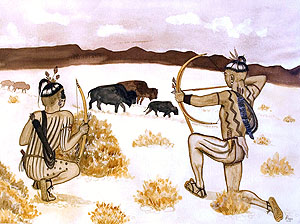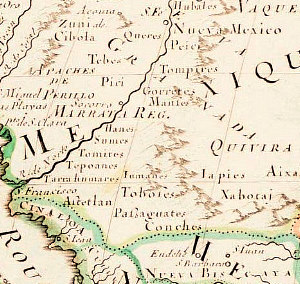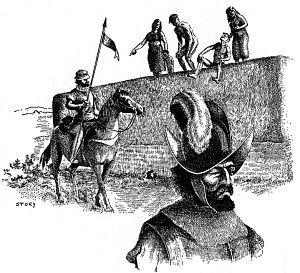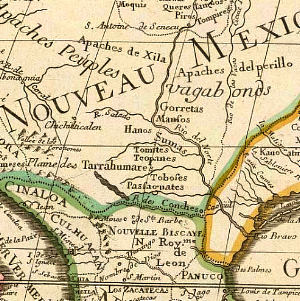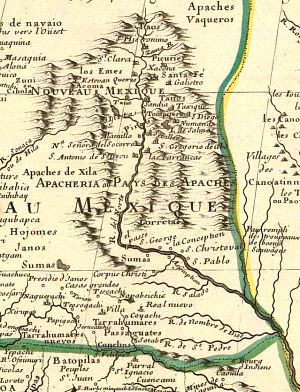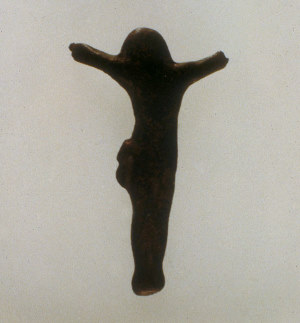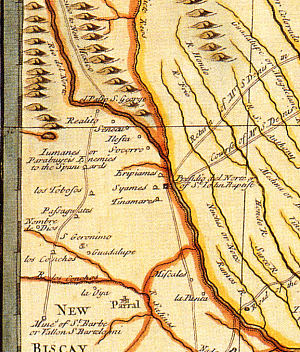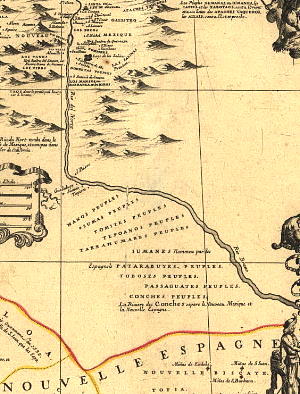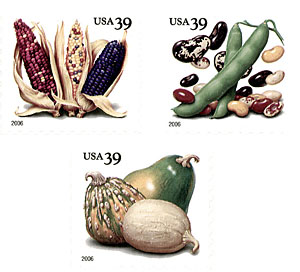Early Encounters 1535-1714
Transcontinental route of Cabeza de Vaca and his companions across south and west Texas and Mexico, as charted by Alex Krieger. The four survivors reached La Junta de los Rios in 1535, the first Europeans to encounter the native peoples there. Map adapted from Krieger (2004), courtesy of University of Texas Press. |
|
In the fall of 1535, Álvar Núñez Cabeza de Vaca and his three companions became the first Europeans to visit La Junta during the final year of their amazing eight-year journey (1528-1536) on foot from Galveston Island to Mexico City (see Learning from Cabeza de Vaca). In the La Junta area they found village settlements spread out along the Río Conchos and Rio Grande. After over seven years of captivity and travel, the natives of La Junta were the first people they had encountered who grew crops and lived in permanent structures within a densely settled locale. The Spaniards called the La Junta peoples with whom they stayed the "People of the Cows" because they had many bison (cow) robes. In fact, at the time they arrived most of the people "had gone to the cows [bison hunting] as this is the season for them." Based on later Spanish visits to the area that documented several different ethnic/tribal groups with differing lifestyles (both villagers and more nomadic groups), it is likely that the cow people were not the only residents of La Junta. But the Spaniards may have only spent time with one group, perhaps because they were allies of the two Indian women from farther south who had guided the party to La Junta. The La Junta people and their settlements are described in a now-lost primary joint account written shortly after the Spaniards reached Mexico City and paraphrased a few years later by 16th-century Spanish historian Gonzalo Fernando de Oviedio y Valdez. But the most authoritative account is Cabeza de Vaca's own account Relación de los Naufragios (Account of the Disasters) written after he had returned to Spain in 1537. While these accounts contain tantalizing details, not all are in agreement and much is left unsaid. The Spanish accounts are difficult to relate to precise localities and to the named native groups described when the next Spanish chroniclers arrived in La Junta some 45 years later. Generalizing, the Cabeza de Vaca party visited or learned of five pueblos (towns) in the La Junta district and found a people who welcomed the travelers, shared their meager foods freely, and impressed the Spanish as "the most obedient we found in this land, of the best disposition, and usually very healthy." They farmed and "ate beans and calabashes [squash or pumpkins]." Some of those the Spanish stayed with did have some maize (corn) which was said to have been brought from the west. The people of La Junta apparently sometimes grew corn, but said they had not been able to successfully plant for two years owing to severe drought conditions. Most of the men were said to "go about completely naked," but the women and a few (older?) men were said to "go about covered with some deer skins." Yet they were said to have given the Spaniards many cotton blankets, strong indications of trade connections to Southwestern cultures. One very odd detail that Cabeza de Vaca relates is that the cow people lacked "ollas" and thus had to cook by stone boiling in "calabazas" (gourds). The Spaniard had never seen this cooking technique before and described it at some length. They gave us to eat beans and squashes. The manner of cooking them is so new that being such I want to set it down here, so that it may be seen and known how diverse and strange are the inventions and industries of human beings. They did not have ollas [pottery vessels] to cook what they wanted to eat [so] they half fill a large gourd with water and into the fire they toss many stones of that kind that will more easily burn. And when they see that the stones are burning they take them up with wooden tongs and put them into that water which is in the gourd until they make it boil with the fire [heat] that the stones carry. And when they see that the water boils they put in it what they want to cook. And during all this time they do not do anything else but take out some stones and toss in others so that the water may [keep] boiling and cooking what they want, and thus they cook. Cabeza de Vaca (Krieger 2002:88). Like most researchers, Alex Krieger, whose 2002 translation and commentary on Cabeza de Vaca's journey we consider to be authoritative on most points, assumed that the Spanish word "ollas" meant pottery vessels. The apparent claim that the cow people lacked pottery is odd because there is abundant archeological evidence of pottery use at La Junta from A.D. 1200 onward. In fact, the ollas = pottery assumption has led some authorities, including J. Charles Kelley early in his career, to believe that Cabeza de Vaca's route had not gone through La Junta. Few researchers today doubt that the pueblos visited by the Spanish travelers in 1535 were indeed those in the immediate vicinity of La Junta. Krieger was certain this was the case, but he was perplexed about the apparent absence of pottery. Ethnohistorian and archeologist Nancy Kenmotsu has advanced an explanation that may clear up the pottery matter. By "olla" Cabeza de Vaca may have meant a large sturdy kettle used to cook food over the fire, not pottery in general, as the word olla is commonly used to mean today. Similarly, "calabazas" may have referred to shallow bowls that resemble calabashes, rather than actual gourds. This example illustrates the challenges inherent in translating and interpreting 16th-century Spanish documents. La Junta was not visited again by Europeans until 1563, when Spanish slavers arrived from Santa Bárbara in north-central Mexico to obtain slaves for the silver mines. They returned to La Junta frequently after that and slave raids peaked in intensity from 1575 to 1585, then continued sporadically until 1760. In response to the slave raids, the native people of La Junta were hostile toward all Spanish intruders, making missionary efforts there extremely difficult. In 1581, Father Augustín Rodríguez, Father Francisco López and Father Juan de Santa María petitioned Viceroy Coruña for permission to visit La Junta and the unexplored province of New Mexico in hopes of converting native people to Christianity. The viceroy sent Sergeant Francisco Sánchez Chamuscado and nine soldiers with them so that they could search for the legendary seven golden cities of Cíbolo. The Rodríguez-Chamuscado entrada arrived at La Junta on July 6th and celebrated what was probably the first mass to be held west of the Pecos River in Texas. They observed that the people of La Junta were living in much the same way that they had when they were visited by Cabeza de Vaca, with the addition of some Spanish introductions, such as watermelon, horses, and livestock. The entrada moved on to New Mexico where the friars remained while the rest of the party left to search for gold. The friars then disappeared, presumably killed by the native peoples they wished to convert. Several after-the-fact accounts of the expedition were produced, with the Gallegos Relación supplying the best information on La Junta. This account describes individual pueblos, and also gives a detailed description of some of the houses and how they were constructed, which very much matches the archeological evidence found in the La Junta district. Groups of Indians referred to as “Conchos,” “Patarabueyes,” and “Amotomancos” were described as living at La Junta, but no references as to the number of pueblos nor the size of the population were given. A later historian, Obregón, indicated the expedition had observed more than 2,000 Indians in the Rio Grande valley, which they named “Valle de Nuestra Señora de la Concepción”. In 1582, cattleman Antonio de Espejo, Father Bernardino Beltrán and 14 soldiers set out on an expedition to find out what had happened to the friars. Espejo already knew the fate of the friars, but he hoped to find gold or silver on the trip so that he could pay a fine that Coruña had imposed on him. The Espejo entrada is documented in the journal of Diego Pérez de Luxán. The group traveled down the Río Conchos, explored the La Junta area, then went up the Rio Grande to New Mexico. The return trip was by way of the Pecos River to the vicinity of Toyah Creek (north-central Reeves County), where they were guided by Jumanos back to La Junta. The Jumanos, a group that figured prominently in the later history of La Junta, have been the subject of much debate and confusion among historians, ethnohistorians, and linguists. In the 16th century their homeland seems to have been in the vicinity of Toyah Creek along the Pecos River and eastward toward San Angelo. They were hunters and gatherers, known for bison hunting and traveling great distances to trade with peoples hundreds of miles from their homeland. Spanish documents dating to the 17th and 18th centuries show that the Jumano were often associated with La Junta, although not as primary residents. The entrada found La Junta to be extremely populous and Espejo estimated that over 10,000 people lived there including the “Omotomoacos” and “Abriaches,” who were collectively referred to as “Patarabueyes.” Patarabuey was a derogatory term probably coined by slavers meaning "ox-kicker" that was used by the Spanish to refer to all of the peoples of La Junta during the 16th century. At this time, the native peoples of La Junta apparently had different languages than those of their neighbors to the south. Espejo was able to meet with the leaders of several of the nations who held celebrations in honor of the Spanish visitors. On this night they carried on great dances and rejoicing. They made music by beating their hands while sitting around a big fire. They sing, and in time with the singing they dance, a few rising from one side and others from the opposite, performing their dances two, four, and eight at a time. Diego Pérez de Luxán (Kelley 1986:54) The La Junta people's hostility toward the Spanish continued until 1598 when the slave raids had become less frequent and missionaries were allowed into La Junta. The Spanish were able to periodically visit the area until 1662 when the native people expelled them in retaliation for an increase in slave raids. The missionaries returned in 1670 and attempted to establish missions, but were unable to do so. In 1677, the missionaries were driven out again when the La Junta Julimes joined the Tobosos and Conchos in a war against the Spanish to stop the slave raids. The Spanish documents of the late 16th century mention several different nations who called La Junta home, but provide few consistent details about most of them. Some of the groups mentioned include the Conejos, Pescados, Puliques, Tapalcolmes, Oposmes, Posalmes, and Mequites. Their neighbors included the Chisos to the east and southeast, and the Conchos, Julimes, and Mamites lived farther west along the Río Conchos. All had long-lived alliances with the peoples of La Junta. The relationships between the different groups who interacted at La Junta were cemented by the exchange of food, material goods, information, and, doubtlessly, intermarriages. Collectively, these La Junta-related peoples fished and hunted fowl, rabbit, hare, bison, and deer. They gathered mesquite, mescal, prickly pear, juniper berries, and lechuguilla, and grew corn, beans, and squash. Some contrasting lifestyles are implied. For instance the Chisos were said to have relied more on the hunting of small game, such as rabbit, mice, and snakes, and only occasionally consumed corn and fish. All of the people who maintained primary residences at La Junta lived in square, flat-roofed pithouses with adobe or mud-plastered walls. Houses were often accompanied by circular granaries made of willow. The first missions at La Junta were established as the result of a ruse by the Jumano chief Juan Sabeata. In the mid-to-late 17th century, "Apache" groups from the Southern Plains began encroaching on Jumano territory and represented a dangerous new threat to the northeastern Spanish provinces. Before this, Jumanos had only sporadically visited La Junta, but by 1682 they were regularly spending their winters there. Many Conchos and Julimes also settled permanently at La Junta during this time. In an effort to protect his people, Sabeata and a delegation of Jumanos visited the governor of New Mexico in 1683 and told him that they had seen a flaming cross on a mountainside at La Junta. The governor agreed to send missionaries to La Junta on the condition that the Jumanos build them a church and living quarters. On the following day, the members of the Jumano delegation sent messengers to take measurements of the altar of the church at El Paso. Juan Domínguez de Mendoza, Father Nicolás López, Father Juan Zavaleta, Father Antonio Acevedo and several soldiers arrived at La Junta two months later and found that the Jumanos had constructed several jacal churches with altars according to the measurements taken by their messengers. The population of La Junta was again said to number about 10,000 and the native people had adopted more European crops, such as wheat and cantaloupes, but were otherwise living in their traditional way. The first Christmas mass in West Texas was celebrated a few days later at Apóstol Santiago, one of the churches constructed by the Jumanos. Soon after that, the entrada embarked on a search for a purported river of pearls on the western Edwards Plateau, leaving only Father Acevedo at La Junta. By López's account, Acevedo baptized over 500 Jumanos and built six jacal missions, but these numbers are probably inflated. In the summer of 1684, the people of La Junta joined the native groups of northern Chihuahua in revolt against the Spanish to protest slave raids. The Jumanos who had been converted fled with the missionaries to Parral in southern Chihuahua, taking the sacred ornaments and vessels from the missions with them. Some of the missions reopened late in the year when things calmed down. After the missions were erected at La Junta, Sabeata was appointed by the Spanish to be a native governor. Sabeata used his status to enhance La Junta's position as a trading center. Long before the arrival of the Spanish, La Junta had been a regional center of trade and after Spanish contact, it maintained its position and began to deal in European goods. Between 1684 and 1694 Sabeata led annual expeditions to conduct trade with the native groups of Chihuahua and central and east Texas, expanding La Junta's influence as far northeast as Tejas territory and as far south as Quivira in northeastern Mexico. In 1685, a group of Jumanos from La Junta visited Juan Isidro de Pardiñas, Governor of Nueva Vizcaya, in Parral to report that "Spanish warriors who did not speak Spanish" had approached within a three-day march of La Junta. Pardiñas suspected that they were Frenchmen from the La Salle expedition and sent two parties to investigate, but they found no one. In 1687, a group of widely traveled Jumanos and Cíbolos asked Father Austín de Colina, President of Missions at La Junta, for a letter stating that they were Christians that they could show to "Spaniards" who were coming and going among the Tejas in East Texas. Colina demanded instead that a letter be brought to him from the foreigners (the French). The Jumanos returned a few months later without a letter and reported that the foreigners were powerful and had never lost a battle. In 1688, five Cíbolos returned to La Junta from a trip to East Texas and reported to Colina that a foreigner had established himself as king over the Coahuiltecans (inclusive name for the native peoples of south Texas and northeastern Mexico; see Who were the Coahuiltecans?). This foreigner was later identified as Jean Jarry, a deserter from the La Salle expedition. Shortly thereafter, other Cíbolos arrived and reported that there were strangers living among the Tejas who had armor and long muskets. Colina became increasingly worried and reported all of this to Pardiñas. In 1689, Juan Fernández de Retaña and 90 soldiers arrived at La Junta on orders of Pardiñas to discover the truth about the French. They were not able to depart from La Junta for several weeks, however, because the native people had once again forced the missions to close in protest of slave raids. They had also become agitated (and encouraged) by rumors that foreigners were coming to La Junta who would return things to the way they were before the Spaniards arrived, would not force the native people to work, would allow them to return to their old beliefs and would give them generous gifts in exchange for gold and silver. When Retaña's party was finally able to pacify the native people and leave for east Texas, they met Sabeata at the Pecos River who told them that most of the French had been killed by the native people of the Gulf Coast and the rest had been captured. He further reported that he was taking some papers and a painting of a ship that had belonged to the Frenchmen to Pardiñas. Sabeata went to Parral and presented Pardiñas with two documents tied up in a lace neck cloth and the painting. He and his native companions apologized for their delay in bringing the items to the governor, saying that "they would have come earlier but for the fact that the time for going into the interior to the fairs which they conduct with the nations of the upper Rio del Norte [New Mexico], the Texas [Tejas], and many other Indian nations, prevented them from doing so." Today these two documents reside in the Archives of the Indies at Seville, Spain and may be the only known relics of the La Salle expedition held by the Spanish. One is a letter requesting that the Spanish help their fellow Christians in battle against the "heathen Indian." (To learn more about the La Salle expedition see The Belle and Fort St. Louis exhibits.) After 1689, there are no known Spanish accounts of official visits to La Junta until 1715, yet it is almost certainly the case that slave raids and other interactions continued. The first 180 years of Spanish-native encounters at La Junta had a profound impact on both groups. Though the native people of La Junta continued to live in many of the same ways that their ancestors had, they quickly adopted Spanish ways that they found useful, such as crops and livestock. They were not as eager to accept Christianity from the Spanish until they found it useful for protection from their enemies, but they rejected it as soon as it lost that utility. Both the native people of La Junta and the Spanish missionaries were affected profoundly by the Spanish slavers. The slavers were an almost constant presence in La Junta, tearing apart families, driving people away from the area and poisoning the relationship between the native people and the Spanish church and state. As a result of the slave raids, Spanish missionaries were driven out of La Junta again and again by the native people. It was not until the slave raids finally ceased that missions could be permanently established at La Junta. |
|
